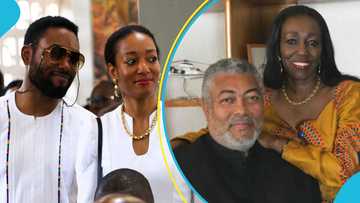What is the history of Okomfo Anokye? Real name, virtues, sword
Okomfo Anokye was one of the founding fathers of the West African Ashanti Empire, the modern-day Ashanti Empire in the Republic of Ghana. He was an influential political and religious leader, and it is believed he performed miracles. This article narrates the story of Okomfo Anokye, including his supernatural powers, political might, and a myth about his wife.
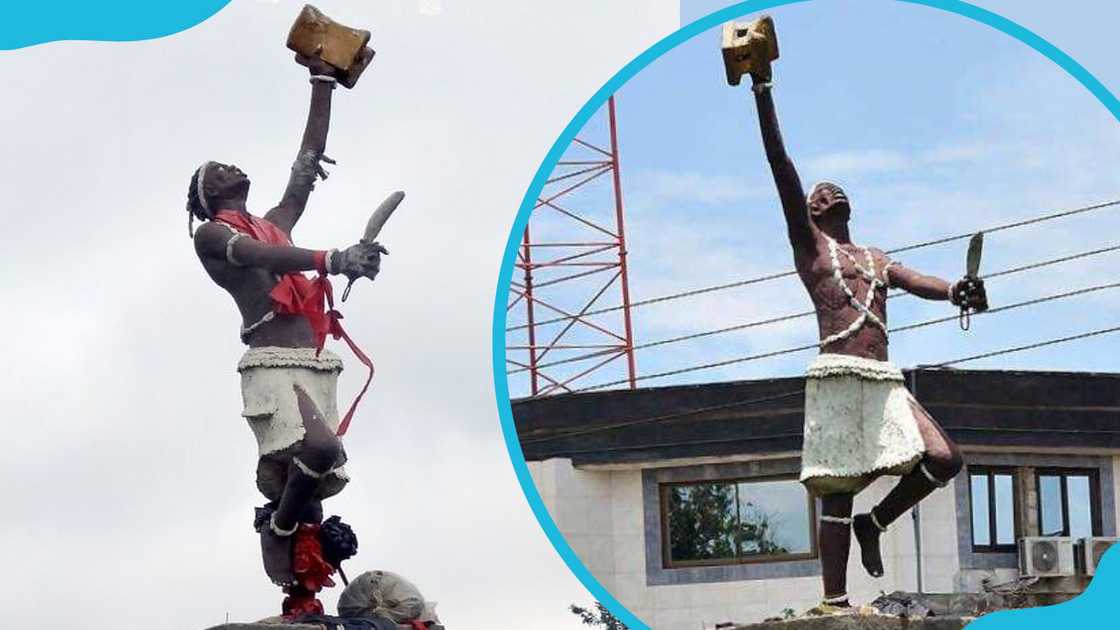
Source: UGC
TABLE OF CONTENTS
- Profile summary
- What is the history of Okomfo Anokye?
- What was Okomfo Anokye's father's name?
- What was Okomfo Anokye holding when he was born?
- What did baby Anokye say to his father?
- Okomfo Anokye's legacy and miracles
- Can Okomfo Anokye's sword be removed?
- Did Okomfo Anokye die or vanish?
- How old was Okomfo Anokye when he died?
- Who did Okomfo Anokye marry?
- What were the best virtues of Okomfo Anokye?
- Is Okomfo Anokye a twin?
- Facts about Okomfo Anokye
Okomfo Anokye convinced the divided Asante chiefdoms to unite under Osei Kofi Tutu I and create the Asante Empire (Asante Twi: Asanteman). Tutu took the Asantehene (king) title in 1695 and ruled until 1717. The empire lasted between 1701 and 1901, with Kumasi as its capital and the Golden Stool of Asante as its unifying symbol. Check out the history of Okomfo Anokye and the Golden Stool below.
Profile summary
Full name | Kwame Anokye Frimpon Kotobre |
Other name (s) | Okomfo Anokye |
Born | 1655 |
Place of birth | Awukugua-Akwapim, Akwamu Kingdom |
Died | Around 1717 - 1719 |
Age | 62 - 64 years (at the time of death) |
Father | Ano from the Adansi tribe |
Mother | Yaa Anubea from the Ashanti tribe |
Legacy | Ashanti fetish priest (traditional spiritual leader) |
Kingdom | Asante Empire (today's Ashanti Empire) |
Regime | 17th century |
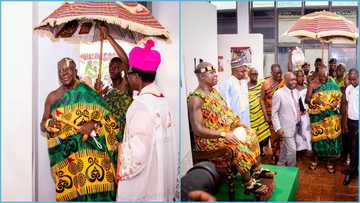
Read also
Asantehene: Effigy of Otumfuo creates confusion due to striking resemblance to real human, photos
What is the real name of Okomfo Anokye?
Okomfo Anokye's real name was Kwame Anokye Frimpon Kotobre. He earned the Okomfo (priest) title when he became an Asante Empire religious leader. As a result, many have known him as Okomfo Anokye throughout history.
What is the history of Okomfo Anokye?
Anokye was born in 1655 in Awukugua-Akwapim, Akwamu kingdom (now in Ghana).
What was Okomfo Anokye's father's name?
His father, Ano, was from the Adansi tribe, while his mother, Yaa Anubea, was an Ashanti.
What was Okomfo Anokye holding when he was born?
He was born holding a short white tail of a cow (Podua) in his right hand, and his left hand was firmly clenched in a fist that no one could open. The midwife called his father to help her open the fist.
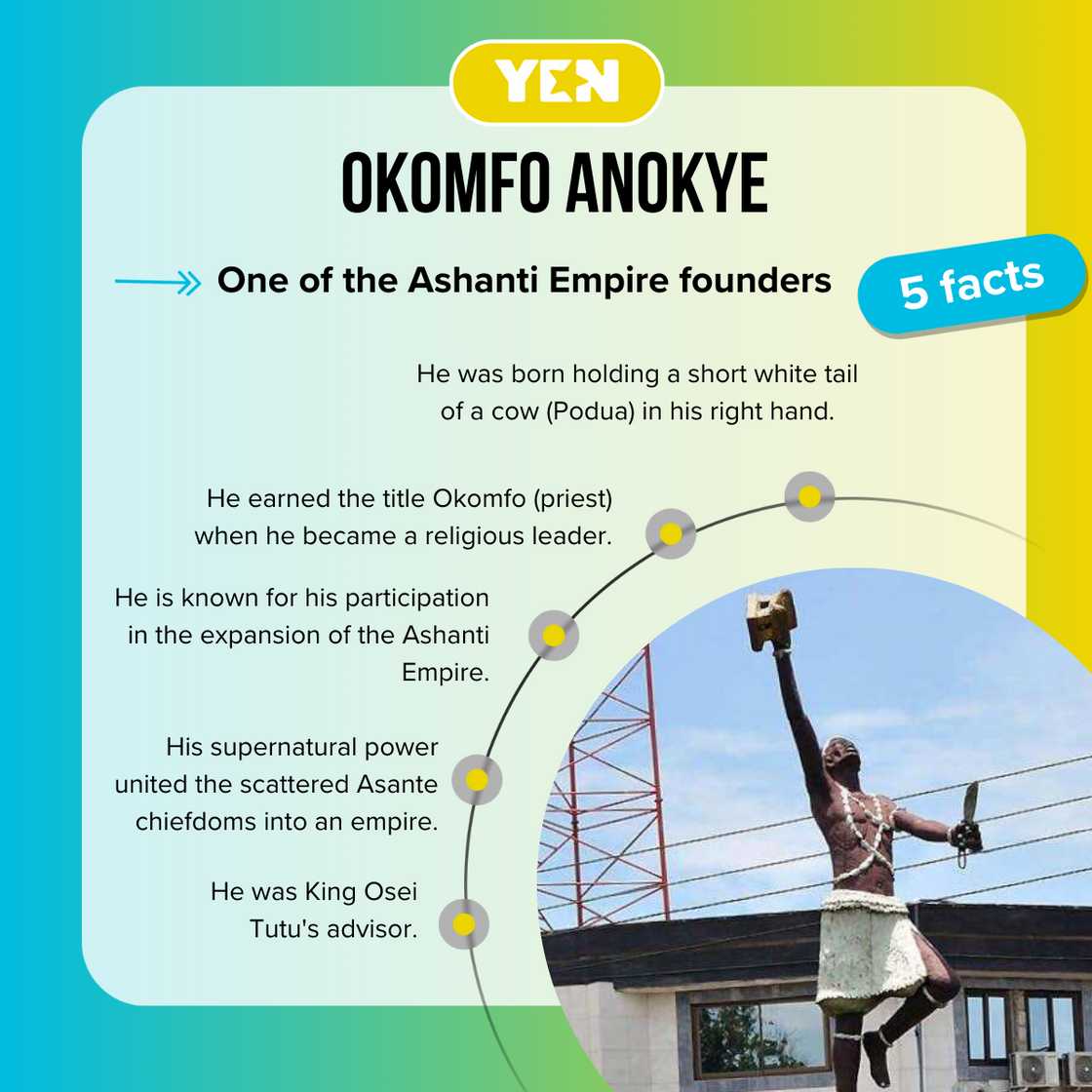
Source: UGC
What did baby Anokye say to his father?
The baby opened his eyes, stared at his dad, opened his hand, and said, "Ano...Kye." The father took the talisman/totem pole (an inscribed ring or stone believed to have magic powers and good luck) from the child's hand and named him Anokye.
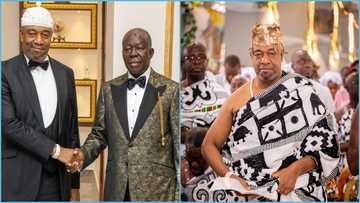
Read also
Otumfuo Osei Tutu II singles out Ga Mantse for praise, thanks him for the support in latest video
The people believed the talisman and Podua were gifts from the gods and signs that Anokye was destined for greatness. He and Osei Tutu would later establish the Asante Empire's legal, philosophical, and political foundation.
Okomfo Anokye's legacy and miracles
When he was alive, the Asante Empire conquered neighboring kingdoms like the Denkyira of the Aka people (1699). The Denkyira-Asante war lasted two years, and the Asante army was initially weak.
Anokye (King Osei Tutu's advisor) reportedly shouted incantations toward the Denkyera army, making most of the Denkyera army generals to defect to the Asante side. As a result, the Asante people defeated the Denkyera and gained the Elmina Castle, and Anokye was considered a mighty priest.
The Elmina Castle granted the Asante Empire access to the coast, where they traded gold, agricultural produce, enslaved people, and craft work with the Dutch and other White settlers.
The empire defeated other kingdoms and expanded from the Ashanti Region to parts of the Ghana Empire, Ivory Coast, and Togo.
Okomfo Anokye's miracles
There are many records of the priest's great deeds and miraculous cures. Some of Okomfo Anokye's miracles include:

Read also
Prime minister of Trinidad and Tobago to visit Ghana for Otumfuo's silver jubilee celebrations
- Okomfo's supernatural power united the scattered Asante chiefdoms into the Asante Empire.
- He commanded the Golden Stool to land on Osei Tutu's knees, thus making him the Asante Empire's first king.
- Anokye's priesthood power helped the Asante conquer the Denkyira in 1699.
- He could teleport from one place to another within seconds.
- He climbed palm trees with his sandals on.
- The priest redirected the flow of rivers.
- The rain never fell into his roofless house.
- Okomfo fetched water in a basket without spilling a drop.
- He planted a magic sword in the ground, which has never been removed.
- He commanded rain to stop falling at a traditional festival.
- Okomfo walked in the rain daily and never got wet.
- A crowd witnessed Okomfo make plantain grow in one day. They harvested and cooked it on the same day.
- Anokye carved a board for Oware (a pit and pebble game) from a stone slab with his bare fingers.
- A palm tree grew at the spot he poured a dreg of palm wine. The tree is in Awukugua town. Its fruit is harvested annually and shared among the area's seven traditional stool holders.
- Anokye drained the Agyempansu and caused it to flow again as the Subin River.
- Anokye spat bits of a small chew stick he had been using to clean his teeth, and a tree grew where the pieces fell.
- He prophesied that Asante would remain intact, at least through the reigns of the first seven Kings.
- Anokye predicted that Mamponhene Boahene Anantuo would die seven days after the Liberation War.
- He foretold that the Europeans would successfully invade Asante when an Asantehene broke the law.
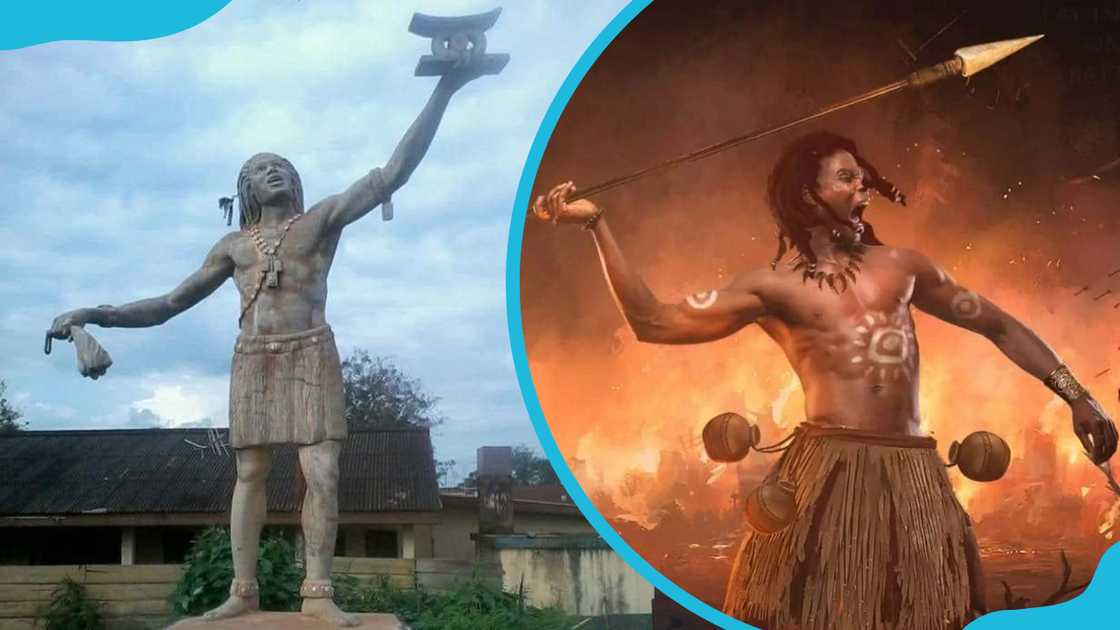
Source: UGC
Can Okomfo Anokye's sword be removed?
King Osei Tutu rewarded him with a massive piece of land in Asante. The Nzema community occupied the land and named it Nzemaa.
Anokye drove a sword into the ground to signify unity between the Ashanti and Nzema communities. It was part of a sealed covenant for them to intermarry and never wage war against each other.
Okomfo Anokye's sword stands to date at a hospital in Kumasi. The people believe removing it will destroy the Asante nation.
Did Okomfo Anokye die or vanish?
When King Osei Tutu died in 1717, Omkofo Anokye returned to his homeland, Akwapim. He passed away between 1717 and 1719 in Kyirapatre, a town in Kumase.
How old was Okomfo Anokye when he died?
Okomfo Anokye's age at his death was between 62 - 64 years. The circumstances surrounding his death were unclear. No one mourned him because it was believed he went to bring the key to death. The people realized he was gone forever when he never returned.

Read also
Otumfuo tells how his royal identity was hidden from him: "I was not allowed to go to Manyhia"
The British forces invade the Asante Empire in the early 1800s. They burnt Kumasi and made the empire part of the Gold Coast colony on January 1, 1902. Today, the Ashanti Kingdom is a constitutionally protected sub-national traditional state under the Republic of Ghana.
Okomfo Anokye is one of the most famous ancient leaders in Ghana. People write songs and poetry in his honor. He warned that chaos would befall the Asante community if the Golden Stool was destroyed.
Dr Kwame Nkrumah stood on it on July 1, 1960, when Arku Korsah swore him in as the first president of the Republic of Ghana in Accra.
Who did Okomfo Anokye marry?
A myth alleges Okomfo Anokye's wife was a Krobo woman who was a commercial sex worker but does not record her name. The story further claims Anokye pronounced a curse on Krobo women for them to be promiscuous till the end of time.
Although it is unclear whether he married, sources have mentioned that he had a son. Okomfo and his son Agyapa went to the kyenkyen tree, which Okomfo climbed to observe Ntim Gyakari’s camp at Feyiase. His footprints were visible in the trunk of the tree after he had climbed down and left the scene.
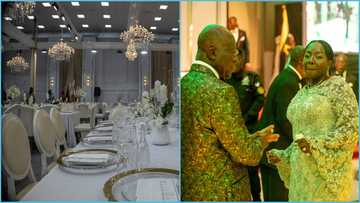
Read also
Otumfuo holds lavish dinner to mark 74th birthday, invites Chiefs, dignitaries: "Royalty speaks"
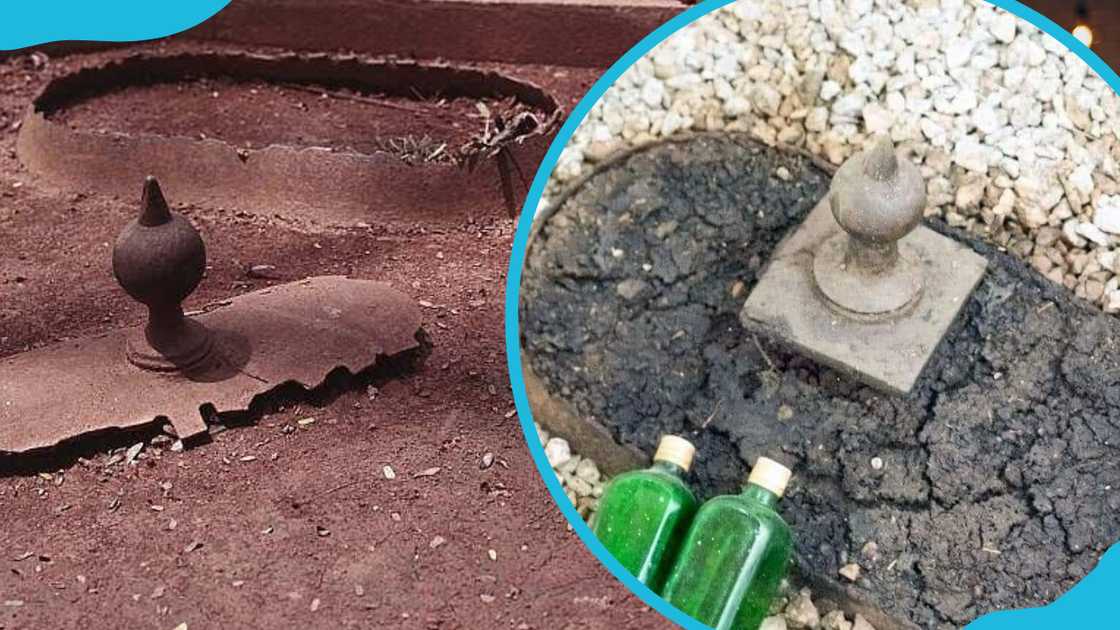
Source: UGC
What were the best virtues of Okomfo Anokye?
According to historians, Anokye had strong oratorical skills and intellectual and psychological capabilities to influence regional states to unite under Osei Tutu to form the Asante Empire.
Is Okomfo Anokye a twin?
Ewe history claims Okomfo Anokye was an Ewe Togbi. His twin brother was Togbi Tsali, and their father was Togbui Akplormada. Brothers Tsali and Tsala (alias Okomfo kye) were endowed with potent spiritual powers. Tsali stayed with his tribe in Nioatse (where the Ewe tribe comes from), while Tgobi went to help the Ashanti in their wars.
Where is the statue of Okomfo?
Okomfo Anokye's statue is at the Komfo Anokye Teaching Hospital's entrance, Bantama road, Kumasi, Ghana.
Where can you learn about Okomfo Anokye in Twi?
Several YouTube channels have shared videos of people narrating the Okomfo Anokye story in Twi to teach the public about this legend and keep his history alive.
Facts about Okomfo Anokye
- Historical statutes do not accurately represent Okomfo Anokye's face.
- He restructured Asante institutions.
- His sandals and the traditional Oware game board (a stone slab) are displayed in Awukugua, Ghana.
- It is believed that King Osei Tutu was Anokye’s uncle.
Okomfo Anokye is one of Ghana's most honored ancient leaders. His guidance and priesthood power made Ashanti the most powerful kingdom in the 1700s and 1800s.
Yen.com.gh also shared a list of current ministers in Ghana and their positions. Many politicians have been in government for years and still hold civil public offices.
The government's work and powers are divided into ministries. Like in other countries, the ministers in Ghana collaborate to make and implement policies.
Source: YEN.com.gh

Chris Ndetei (Lifestyle writer) Christopher Ndetei is a writer who joined the Yen team in May 2021. He graduated from Machakos Technical College in 2009 with a Diploma in ICT and has over four years of experience in SEO writing. Christopher specialises in lifestyle and entertainment coverage, with a focus on biographies, life hacks, gaming, and guides. He has completed the AFP course on Digital Investigation Techniques (2023) and earned the Google News Initiative Certificate (2024). In recognition of his work, he was named Yen Writer of the Year in 2024. You can connect with him via email at chrisndetei@gmail.com.

Peris Walubengo (Lifestyle writer) Peris Walubengo has vast experience in search engine optimization through digital content generation, research, editing, and proofreading. She joined Yen.com.gh in April 2022 and has done several Google News Initiative Courses. You can email her at perisrodah254@gmail.com.

